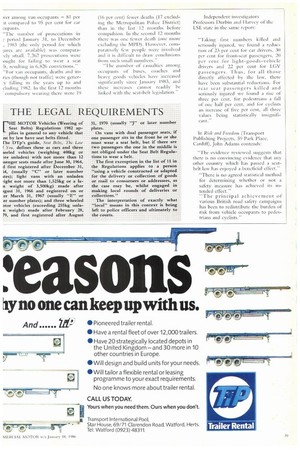THE LEGAL REQUIREMENTS
Page 39

If you've noticed an error in this article please click here to report it so we can fix it.
[HE MOTOR Vehicles (Wearing of Seat Belts) Regulations 1982 applies in general to any vehicle that 1st by law have seat belts fitted.
Fhe DTp's guide, Seat BelaN, The Law Yet,, defines these as cars and three teeled vehicles (weighing 408kg or )re unladen) with not more than 12 ssenger seats made after June 30, 1964, d first registered after December 31, i4, (usually "C" or later number ites); light vans with an unladen ight not more than 1,525kg or a la n weight of 3,500kg) made after igust 31, 1966 and registered on or cr March 31, 1967 (usually "E" or er number plates); and three wheeled otor vehicles (exceeding 255kg unla
n weight) made after February 28, 79, and first registered after August
31, 1970 (usually "J" or later number plates.
On vans with dual passenger seats, if one passenger sits in the front he or she must wear a seat belt, but if there are two passengers the one in the middle is not obliged under the Seat Belt Regulations to wear a belt.
The first exemption in the list of 11 in the Regulations applies to a person "using a vehicle constructed or adapted for the delivery or collection of goods or mail to consumers or addressees, as the case may be, whilst engaged in making local rounds of deliveries or collections."
The interpretation of exactly what "local" means in this context is being left to police officers and ultimately to the courts.






















































